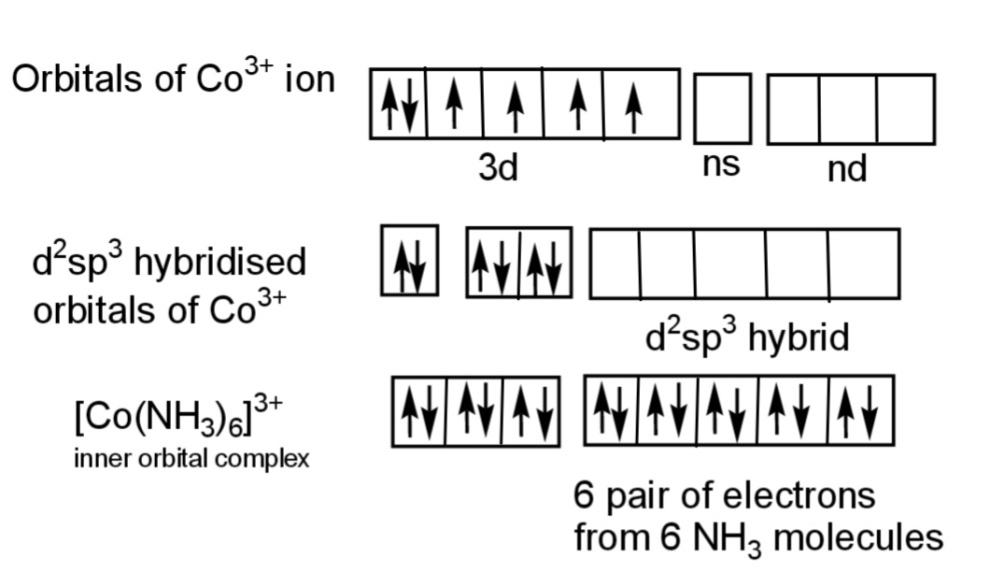
Which of the following is inner orbital complex as well as diamagnetic in nature?
A.
B.
C.
D.
Answer
436.2k+ views
1 likes
Hint: A chemical complex contains a central metal atom attached with different ligands. When the hybridization of the central metal consists of the filling of inner d – orbital, and the outer electron in the s and p orbital, then the complex is inner orbital complex. Diamagnetic compounds consist of no unpaired electrons.
Complete answer:
A chemical compound having a central metal atom attached with ligands is called a complex. The electronic configuration of the central metal atom defines the hybridization of the complex. A complex that has the valence electrons of the central metal atom in the outer d orbitals are called outer orbital complexes, while in the metal atom, when the valence electrons are present in the inner d orbital it is called inner orbital complex. This is because the vacant d – orbital of the metals take part in bonding with the ligands and making complexes.
Among the given complexes, the central atoms has the electronic configurations as,
The diagram shows the diamagnetic nature of

Hence, the complex that is inner orbital and is diamagnetic is
So option D is correct.
Note:
A strong ligand is that ligand which is able to pair up the electrons of the central metal atom, while a weak ligand is not able to pair up the electrons. A complex which has few or no unpaired electrons is of low spin, which are mostly the inner orbital complexes, while the outer orbital complexes have high spin as they have weak field and more unpaired electrons.
Complete answer:
A chemical compound having a central metal atom attached with ligands is called a complex. The electronic configuration of the central metal atom defines the hybridization of the complex. A complex that has the valence electrons of the central metal atom in the outer d orbitals are called outer orbital complexes, while in the metal atom, when the valence electrons are present in the inner d orbital it is called inner orbital complex. This is because the vacant d – orbital of the metals take part in bonding with the ligands and making complexes.
Among the given complexes, the central atoms has the electronic configurations as,
The diagram shows the diamagnetic nature of

Hence, the complex that is inner orbital and is diamagnetic is
So option D is correct.
Note:
A strong ligand is that ligand which is able to pair up the electrons of the central metal atom, while a weak ligand is not able to pair up the electrons. A complex which has few or no unpaired electrons is of low spin, which are mostly the inner orbital complexes, while the outer orbital complexes have high spin as they have weak field and more unpaired electrons.
Latest Vedantu courses for you
Grade 11 Science PCM | CBSE | SCHOOL | English
CBSE (2025-26)
School Full course for CBSE students
₹41,848 per year
Recently Updated Pages
Master Class 9 General Knowledge: Engaging Questions & Answers for Success

Earth rotates from West to east ATrue BFalse class 6 social science CBSE

The easternmost longitude of India is A 97circ 25E class 6 social science CBSE

Write the given sentence in the passive voice Ann cant class 6 CBSE

Convert 1 foot into meters A030 meter B03048 meter-class-6-maths-CBSE

What is the LCM of 30 and 40 class 6 maths CBSE

Trending doubts
What is the difference between superposition and e class 11 physics CBSE

State and prove Bernoullis theorem class 11 physics CBSE

Which one is a true fish A Jellyfish B Starfish C Dogfish class 11 biology CBSE

1 ton equals to A 100 kg B 1000 kg C 10 kg D 10000 class 11 physics CBSE

State the laws of reflection of light

One Metric ton is equal to kg A 10000 B 1000 C 100 class 11 physics CBSE




